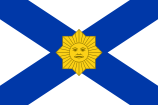Flag_of_Uruguay
Flag of Uruguay
National flag
The national flag of Uruguay (Spanish: Pabellón Nacional) is one of the three official flags of Uruguay along with the flag of Artigas and the flag of the Treinta y Tres. It has a field of nine equal horizontal stripes alternating white and blue. The canton is white, charged with the Sun of May, from which 16 rays extend, alternating between triangular and wavy.[1] The flag was first adopted by law on 18 December 1828, and had 19 alternating stripes of white and blue until 11 July 1830, when a new law reduced the number of alternating stripes to nine.[2] The flag was designed by Joaquín Suárez.[2]
 | |
| The National Pavilion (Official) | |
| Use | National flag and ensign |
|---|---|
| Proportion | 2:3 |
| Adopted | 18 December 1828; 195 years ago (1828-12-18) (first design) 11 July 1830; 193 years ago (1830-07-11) (modification) |
| Design | Four horizontal stripes of blue with the upper hoist-side corner bearing the Sun of May in the centre over a white canvas. |
| Designed by | Joaquín Suárez |
 | |
| Use | Naval jack |
The horizontal stripes on the flag represent the nine original departments of Uruguay, based on the U.S. flag, where the stripes represent the original 13 colonies. The first flag designed in 1828 had 9 light blue stripes; this number was reduced to 4 in 1830 due to visibility problems from distance. The stripes of blue and white were inspired by the flag of Argentina, making the flag of Uruguay part of both the Stars and Stripes and Belgrano flag families.[3]
The golden Sun of May represents the May Revolution of 1810; the Sun of May is a figurative sun that represents Inti, the sun god and mythological founder of the Incan Empire. It also appears in the Flag of Argentina and the Coat of Arms of Bolivia.
The specific color hues of the flag are not officially defined by law. However, most representations use the following:
| Yellow | Brown | Blue | White | |
|---|---|---|---|---|
| RGB | 252-209-22 | 123-63-0 | 0-56-168 | 255-255-255 |
| Hexadecimal | #fcd116 | #7b3f00 | #0038a8 | #FFFFFF |
| CMYK | 0-17-91-1 | 0-49-100-52 | 100-67-0-34 | 0-0-0-0 |
The National Pavilion shares its official status with two other flags, although it possesses a higher hierarchical position amongst them:
During Spanish rule:
Independence from Spain:
- Flag of Provincias Unidas del Río de la Plata from 1813 to 1816
- Flag of Liga Federal between 1815 and 1817
Flag of Cisplatina, under Portuguese/Brazilian rule between 1821 and 1825:
Uruguayan independence and reunification with the United Provinces (1825-1828):
Historical flags
Variations
During the Great Siege of Montevideo (1843–1851) Uruguay had two parallel governments, with two different flags:
- Flag used by the Government of the Cerrito during the Uruguayan Civil War.
- Flag used by the Government of the Defense during the Uruguayan Civil War.
In accordance with Law No. 9,935 of June 14, 1940, in all public and private educational institutes "the Pledge of Allegiance to the Flag will be solemnly performed on June 19."[4] Likewise, Article 28 of the Law No. 9,943, establishes that every natural or legal citizen of Uruguay must take an Pledge of Allegiance to the National Flag.[5]
On June 19 of each year, the Promise of Allegiance to the Flag is taken for first-year primary school children and the Pledge of Allegiance to the Flag is taken for first-year secondary school children.[6]
Public educational institutes that do not carry out the ceremony may be subject to administrative sanctions and private ones may be fined.[7] The lack of the Pledge of Allegiance to the flag carries sanctions such as the impossibility of issuing professional or technical titles, and access to work in the public service.[8][9]
|
|
|
|
- Flag in the historical Estadio Centenario, Montevideo.
- Flag in the Estadio Centenario
- Flag in Colonia del Sacramento
- Flag in the Palacio Legislativo
- Historical Flag from the 1924 Olympic Games
- Flag in Otranto
Departments
- "Flag of Uruguay". The World Factbook. Central Intelligence Agency. Archived from the original on June 13, 2007. Retrieved June 27, 2007.
- Smith, Whitney. "Uruguay, flag of". Guide to Hispanic Heritage. Encyclopaedia Britannica. Archived from the original on December 1, 2011. Retrieved June 27, 2007.
- Znamierowski, Alfred (2013). The World Encyclopedia of Flags: The Definitive Guide to International Flags, Banners, Standards and Ensigns, with Over 1400 Illustration. Lorenz Books. p. 114. ISBN 978-0-7548-2629-3.
- "Ley N° 9935". www.impo.com.uy. Retrieved 2023-11-01.
- "Ley N° 9943". www.impo.com.uy. Retrieved 2023-11-01.
- "Historia de la fidelidad y jura a la Bandera en el mundo | Administración Nacional de Educación Pública". 2022-06-28. Archived from the original on 2022-06-28. Retrieved 2023-11-01.
- "La Jura de la Bandera: ¿"Un símbolo de orgullo nacional" o un "simple papelito sellado"?". Montevideo Portal (in Spanish). Retrieved 2023-11-01.
- Redacción. "¿Para qué sirve la Jura de la Bandera?". El Observador. Retrieved 2023-11-01.
- "Jurar y prometer la Bandera: ¿cuál es la justificación de este evento?". EL PAIS. 2021-09-20. Retrieved 2023-11-01.
- "PROMESA Y JURA DE LA BANDERA". Administración Nacional de Educación Pública.